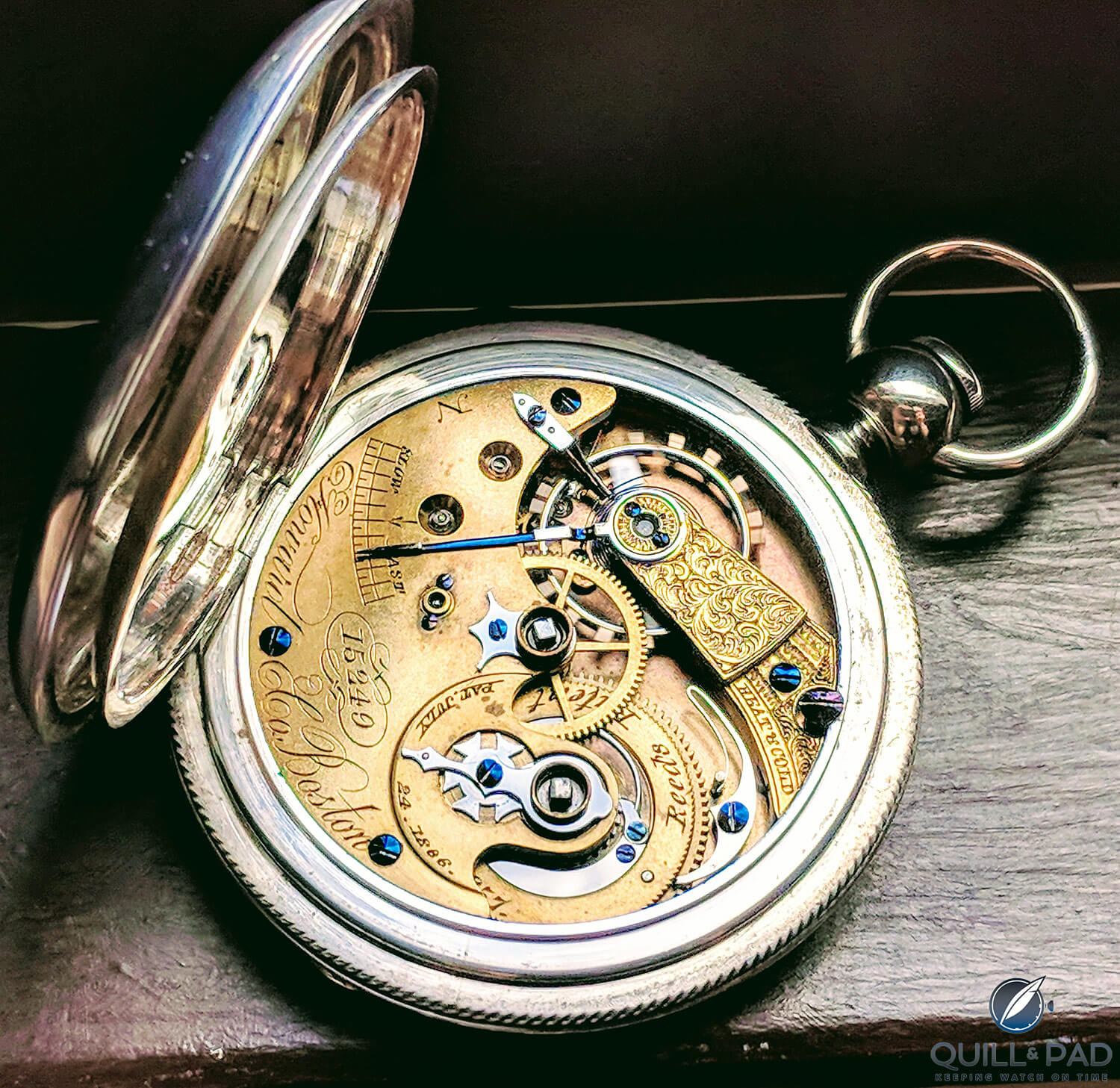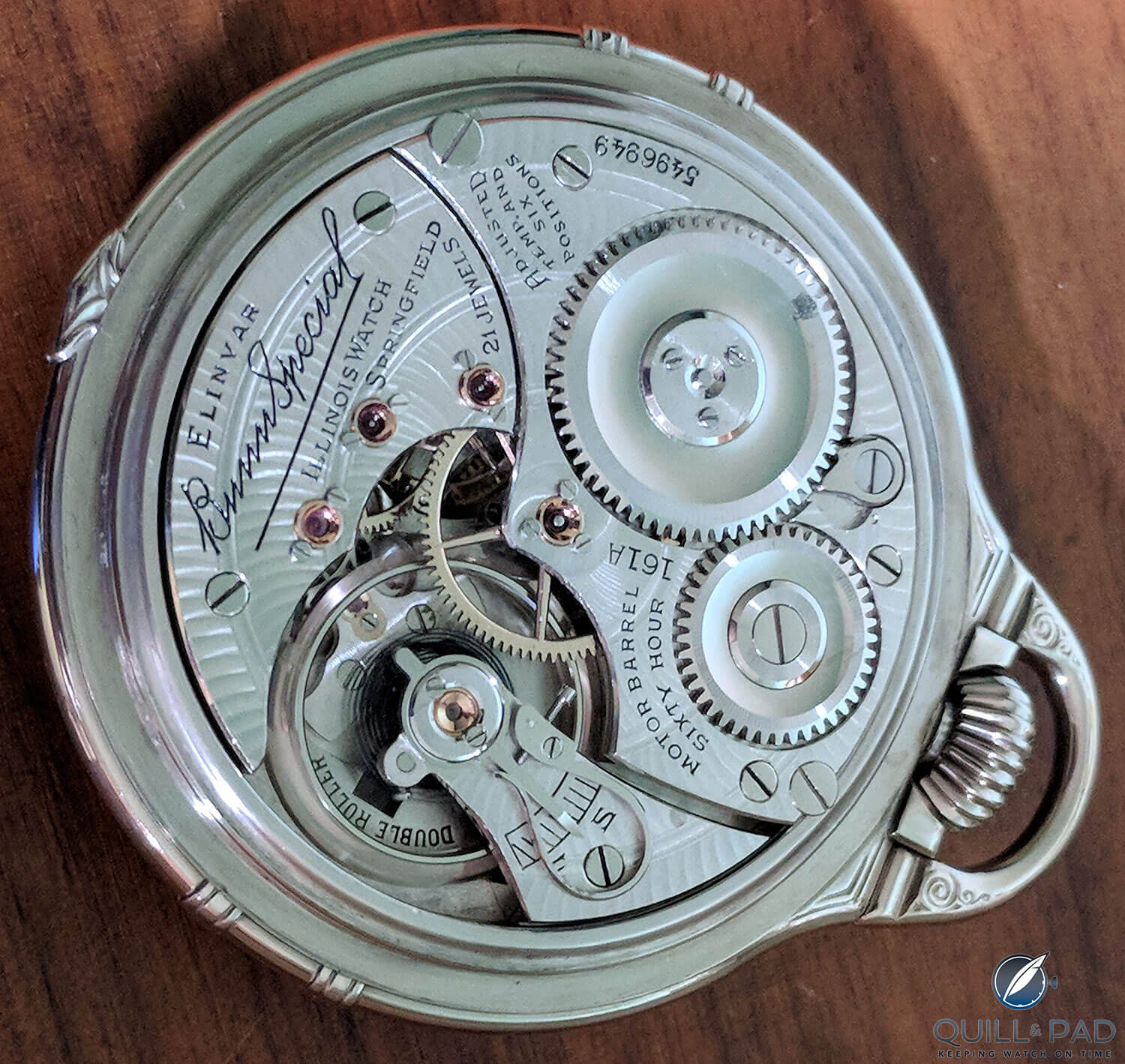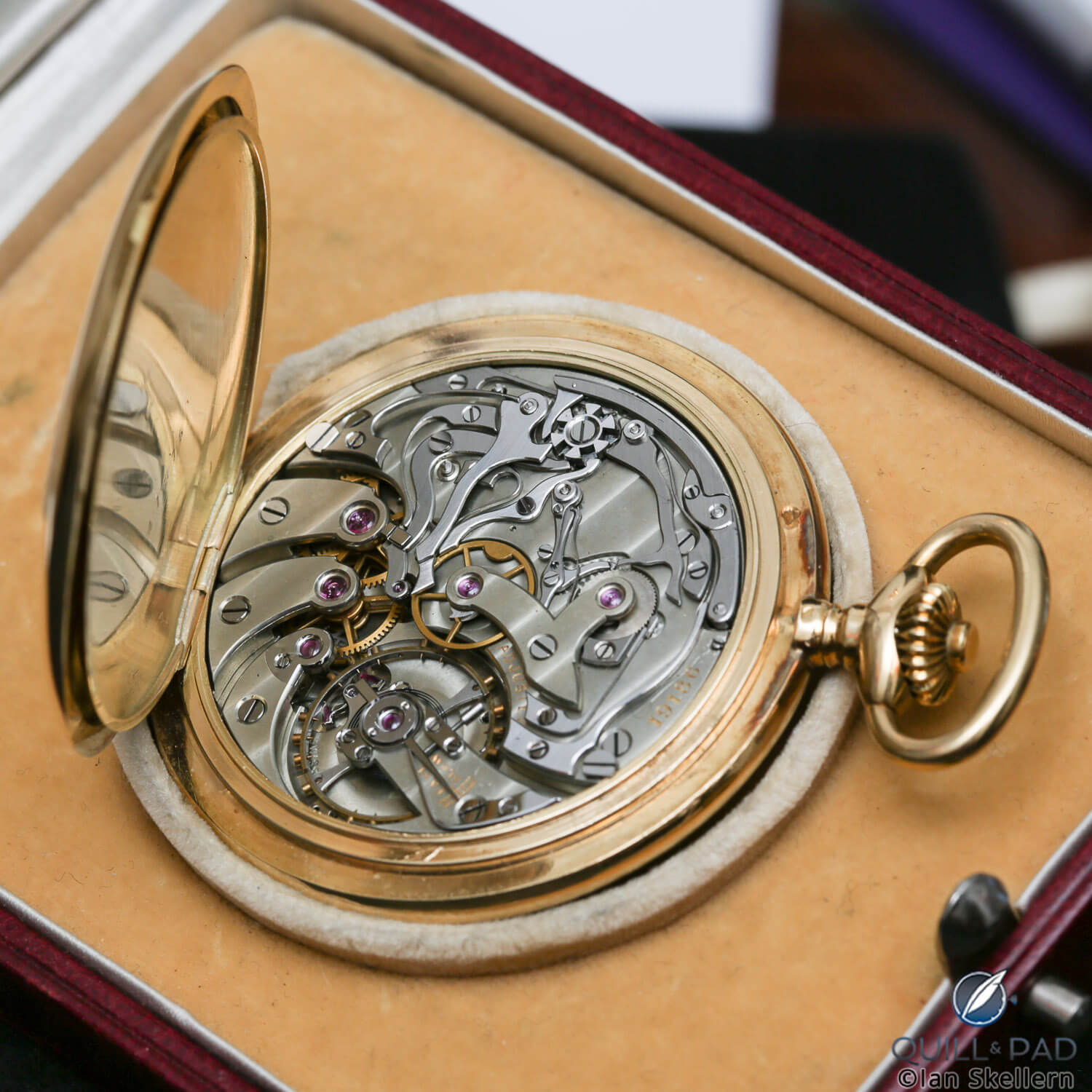As I link the small silver key back to its chain, I glance at my watch before sliding it gently into my right vest pocket. It has been there all night waiting for me, quietly beating away, looking forward to the morning winding of its mainspring’s coils.

Howard and Co pocket watch (photo courtesy Derek Weinberg)
It is at this moment in time I cannot help but think of how far watches have evolved. To me, mechanical watchmaking is the most extraordinary combination of engineering, art, and the highest levels of craftsmanship.
In the society we live in, a society of technology-driven mass production and digital revolution, a mechanical timepiece has become less of an item of function and more a collectible object serving to satisfy its owner from behind a pane of glass rather than as a faithful companion in a busy life.
What has happened to mechanical watchmaking and where is its place in our world now?
We live in a time when it has become easier to replace something than to repair it. If my mobile phone falls on the sidewalk, I purchase a new one rather than dismantle it to fix the damage. If I crash my bicycle in the street, I buy a new one because the cost is less expensive than the time and effort to have it repaired.
But what do we do with our watches as the resurgence of mechanical timekeepers grows around us? Is the craftsmanship within them still valued or is it slowly slipping away, gradually being retired to suit the needs of our electronically charged planet?
For centuries, watches have been built to tick forever with their only dependence being on routine service for cleaning, adjustments, and fresh oil. Of course, accidents happen and repairs are needed, but the mechanical movements of watches were initially designed to outlast the hands that made them.

Illinois Bunn Special railroad chronometer, circa 1931 (photo courtesy Derek Weinberg)
Engraved on their metal plates and underneath their most vital components were serial numbers created to catalog the year of a watch’s birth and to safeguard the originality of all parts present when an appointment came due for service or repair. When the watchmaker’s work was completed, one could rest peacefully knowing that the exact watch was returned containing the components it was created with (or not).
This process instilled value in a timepiece that was not only recognized and apparent but also sentimental through knowing that a well-made mechanical watch would always function in the generations to supersede us.
Fast-forward to our new millennium in which computer-aided manufacturing has brought us the instant interchangeability of parts among a whole. Damaged components are discarded rather than repaired, their engraved numbers assuming new and unmistakable identities through quick laser etching (see Reduction In Wait Times For Watch Servicing Repair And The Disturbing Reality Of What It Means For You).
The artistry once attributed to such mechanical masterpieces has been largely abandoned and the originality of their components substituted by no more than a finger on the switch of an automated assembly line in most cases.
In our world now, a watch movement no longer needs to be built to survive but only built to be swapped out, in many cases without its owner’s knowledge. Modern mechanical watches are not like those of the past, which were made with care and could belong to the everyday man and woman.
They are expensive and reserve themselves only for those possessing the deepest pockets, which no longer serve to carry them.

A Poitevin-LeJeune pocket watch chronograph from Gerd-Rüdiger Lang’s collection
Evolution of mechanical watchmaking
When I glance at my timepiece each morning, it is this evolution I think about. It is these modern watches that I fear.
I do not dispute that there are current manufacturers who still practice the traditional methods of watchmaking without abusing the benefits of our technological advances. However, many have misplaced the beauty of a mechanical movement in acceptance of false prestige and financial gain.
Why does a watch no longer need to be entirely crafted under one roof to rightfully declare its origin? Why have such inscriptions on a timepiece’s dial become the result of an international game of shifting percentages to legally qualify that claim?
A century ago, the watch industry respected a watchmaker’s work. And now, firmly entrenched in the revival of mechanical timepieces, how do we regain such dignity?
The questions I pose are not meant for the sake of casual debate, but for solemn reflection within our horological society. The mechanical watch has the potential to reclaim its purpose in our modern lives should we allow it to.
Fine watchmaking can beat strongly once again if we merely pause for a moment to recognize that the only obstacles standing in its path are the ones we have created.
Please let us know your thoughts in the comments below.
You may also enjoy:
Reduction In Wait Times For Watch Servicing Repair And The Disturbing Reality Of What It Means For You
The Number Of Jewels In A Watch Movement Indicates Value, Doesn’t IT? A Myth Debunked
Fauxtina: A Faux Vintage Faux Pas
Leave a Reply
Want to join the discussion?Feel free to contribute!





















































You need to give specific examples. Of course, you won’t do that because it will limit your access to certain brands.
If we compare modern watchmaking to the nineteenth century and before, it cannot be denied that manufacture using hand tools under one roof has become quite rare. On the other hand, it is only a recent development that the ‘holy trinity’ (Patek, Audemars, Vacheron) and their ilk manufacture their watches using components and movements built in house.
I do agree however with much of what the writer is saying. I for one do not own a Rolex, as I see no reason to invest thousands of dollars in a machine-made automatic movement that in reality is no better than a G-Shock. For these reasons I stick with Patek and the Independents.
Perhaps this assessment is true for the Pateks of the world, but I seriously doubt that when Heuer was churning out chronos in the early 70s to sell at discount if you mailed in a cigarette carton label, they were considering the vast horological artistry that those watches would be extending to future generations.
What you are talking about was already a thing of the past one century ago, though. Standardization (as opposed to building one component to match the previous one) was on its way in Switzerland to compete with the US, and most watches were not built under one roof at all. So yu are apparently nostalgic of watchmaking from more like two centuries ago…
There’s a lot to be said about the younger buyers of mechanical time pieces, the thought of servicing is a turn off ($$$) and most never own it long enough, in that the watch was flipped out of the collection 1 or 2 times before the overhaul is due. Used Breitling Navitimers for example have flooded the market lately.
Also, after a horrible service experience 12 years ago with my Speedmaster ( serviced Lancaster, PA) l don’t really trust Omega in long term ownership. Their marketing is all about buy now. As far as l have experienced the owner will pay dearly for servicing and that is where Omega will screw you with bad Quality Control. The younger buyers know this and if there’s a problem, the watch is gone, it won’t be delt with at all. And one more thing, when they ask to buy another strap and its $400, watch companies cannot get it through their marking heads that they lose customers…it’s a turn off of total watch ownership when you charge that much for replacement straps after already buying the watch. The ownership experience is gone.
(quote) A century ago …(unquote).
Happily typing on my computer which did not exist a century ago. My job did not exist a century ago, in fact, none of the items on my desk existed a century ago. even a wristwatch barely existed a century ago.
I recently read an interesting question: what would a Abraham Breguet be doing if he was around, today. The answer proposed by the blogger was: “not watchmaking”. probably an acid joke, but in 1800s watchmaking was a weapon of naval wars, a way to confirm supremacy over new mapped territories and an industrial competitive advantage. Today, watchmaking is “an old habit with tough skin”. The modern watchmaking: an industry that in the past produced an item critical to most people daily lives, is now mobile phone manufacturing. Not many cotes de Geneve on these for now, but this could change in the future, who knows.
Is your main question : how do we restore the dignity of watchmakers?
have they lost their dignity? Where? How?
are we talking about the actual highly qualified professionals on the bench, or are we talking watchmakers in the sense of a brand with a modest team of 10-200 employees who usually market themselves under the family name of the “master watchmaker”.
To me, nobody has lost its dignity. The question is silly (pun intended)
Watchmaking is a business, not aristocracy or a religion (although some collectors tend to think the later)
It was business driven 100y ago, it is business driven today and it will be business driven tomorrow.
There is no golden age of the dignity in watchmaking, and not one that would happen to be in the past. There were very different demands satisfied by very different business models 100y ago.
Today, the big brands invest 8 to 9 times more in marketing than they do in R&D simply because Marketing spending help much more to sell a luxury useless (in the sense of an obsolete timing) device than advances in R&D.
Nobody does watches today like they were done 100y ago (well may be 100 to 200 watches per year in the world could be considered made with techniques similar to what was the high end 100y ago, but that is a drop in the sea of even only high end mechanical timepieces). Since john Harrison, watchmaking has always been driven by the need/wish to industrialize production of time pieces. He created a technical marvel and right after the “client” asked to “industrialize” the marvel so that every ship could have one, and it had to be also cost effective.
If one wants to consider that manual work has more dignity than machine work, then against that criteria dignity is now disappearing day by day in the watchmaking industry. Some movements nowadays are nearly entirely assembled by robots. no more dignity in that part, because there is no more people on that line. This happens in high end brands as well (looking at you, the brand with the crown).
Clients who purchase a high end modern timepiece that is the result of business driven choices of the brand to still mix some old fairly manual decoration techniques with high precision Liga produced parts does not diminish the “dignity” of any of the people working on that product. Now as automation and robotization become more present and keeping in mind that watchmaking industry has been historically fairly good at implementing the latest manufacturing techniques, there will be less and less people on the benches, and therefore less and less “dignity to have”.
Can the consumer change that: mostly no, but yes for the high-end niche, to a certain extend. Buying high end (fairly) hand made watches is a way to preserve and sponsor the “dignity” of human work. The luxury nature of time pieces is only going to increase with time (along with other dramatic changes in the landscape of mechanical timepieces market) and therefore it might still be possible for a brand to afford to have watchmakers on benches.
consider pharmacists, 100y ago: they were the “watchmakers” of their craft, carefully manufacturing remedies by hand, on demand, in a lengthy process that would take years to master. Nowadays they are mostly doing the sales and marketing and not much of the “by hand” manufacturing. Did they lose their dignity as well in the process? I let you be the judge.
Excellent response
Hey Derek – The Bunn Special you illustrate was a $100 movement in 1904 – the equivalent of $2700 today.
https://mb.nawcc.org/attachments/1904-illinois-jpg.254741/
That’s more than an Uhrenwerke-Dresden. That’s double an entry-level Vaucher-Fleurer. That’s ten times an ETA 2697 from Esslinger. I could buy *seventy* Miyota 8215 movements for that kind of money.
Apples to apples, buddy, not Volkswagens to Porsches.
Hi Seth,
Thank you for your comment.
Does the vast drop in quality from American railroad chronometers to modern Miyota and ETA movements not raise concern for the preservation of craftsmanship in mechanical watchmaking?
For me, regardless of how many low quality timepieces I could purchase made available by modern mass production, I would always elect to buy an older watch because its superior quality has been proven over time.
Regards,
Derek
Derek, the Santa Fe Railroad bought railroad chronometers because they needed accurate timekeeping. Aficionados bought railroad chronometers because the Santa Fe Railroad bought them. Nowadays anybody with a cell phone has time accurate to one second in 300 million years, thanks to NIST-F2, thereby putting a COSC chronometer at ten full orders of magnitude less accurate than a cell phone.
Yet mechanical watches exist.
A railroad chronometer was held to 30 seconds a week – definitely an impressive mechanical feat. But I can get a Tissot Powermatic 80 with COSC certification (7 seconds a week) for a thousand dollars; accounting for inflation, half the cost of your Bunn Special.
Is the finish as nice? No. Would I rather have a Bunn Special? Sure. But again, apples to apples – this isn’t a “quality” discussion. The complications and manufacturing processes available to modern watchmakers would be the envy of any craftsman a hundred years ago. What’s changed is that the audience has shrunk. There aren’t nearly as many people who need a hand-crafted mechanical chronometer.
But for people who want a hand-crafted mechanical chronometer, the prices have come down radically thanks to modern production techniques. And for people who simply need to know what time it is, NIST atomic clocks are virtually inescapable.
It’s been three years since Johnny Ive said “the Swiss are fucked” yet sales are up every year – in fact, 2017 watch sales are *ten times* 1973 watch sales when adjusted for inflation. Yet for some reason it’s de rigeur to mourn for “the good old days.”
They’re here, man. We’re living them.